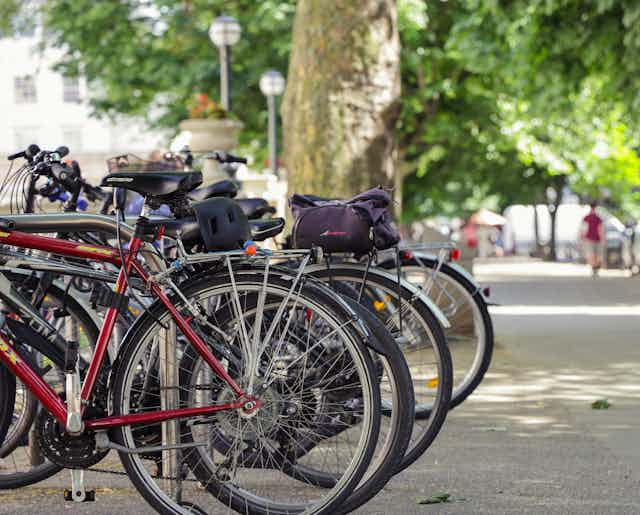The UK was one of the first nations to legislate a net zero emissions target in June 2019. Other nations have since followed suit, most significantly China. Xi Jinping, the leader of the world’s largest polluter, promised to bring his country’s net carbon emissions to zero by 2060 during a speech to the UN in September 2020.
Many businesses and regional authorities have adopted similar targets. But while setting targets is easy, hitting them is another matter. And you could be forgiven for doubting the marksmanship of our leaders.
The Committee on Climate Change has set out the first detailed blueprint for how a nation can hit its net zero target by 2050. After two years collecting and analysing evidence from academics, businesses, the government and the public, our 1,000 page report presents five pathways – five slightly different approaches, each involving a different mix and schedule of policy measures – to deliver a net zero UK.
From a walk to a sprint
Emissions within the UK have fallen by more than 40% since 1990. When accounting for emissions that came from goods produced outside the UK but consumed within it, this figure falls to less than 20%. Nevertheless, this still represents significant progress. Most of the improvement initially came from shifting electricity generation from coal to gas. More recently, a big push into offshore wind has helped advance this trend.
In each of our five pathways, the decarbonisation of the UK’s electricity supply continues apace, so that there are no new gas power plants being built after 2030 without carbon capture and storage, and our electricity is virtually carbon-neutral in all pathways from 2035. But the transport sector, energy use in buildings, farming and the manufacturing sector are currently larger sources of emissions than electricity generation. So much of the emission cuts over the next few decades need to come from these four sectors, in which previous green policies have largely failed.

Transport emissions are still growing despite a number of polices, such as bike-to-work schemes and tax regimes designed to encourage passengers out of cars or into less-polluting vehicles. Because of their failure to reduce emissions, our pathways forecast minor emission reductions between 2020 and 2025. But during this period, the groundwork for rapid decarbonisation at the end of the decade will be laid.
All change on the home front
The 2020s will be a decade of turning niche technologies, such as heat pumps and hydrogen-powered vehicles, into mainstream ones, developing carbon capture and storage technologies, and increasing tree planting rates to over 25,000 hectares per year by 2025. The 2030s will be for rolling these technologies out en masse to completely replace older, high-carbon alternatives such as gas-fired boilers and petrol cars.
Read more: Should you get a heat pump? Here's how they compare to a gas boiler
A new strategy must begin in 2021 to retrofit old buildings and design new ones so that they produce no emissions and are resilient to the changing climate. All new homes will need to be zero-carbon by 2025 at the latest. By the end of the decade, all of the UK’s housing will need to meet stringent efficiency standards and gas boilers will need to be largely phased out by 2033, replaced by hydrogen boilers or heat pumps.
The government has already announced a 2030 ban on sales of new petrol and diesel cars and vans. But a more comprehensive transport plan is needed in 2021. This should aim to reduce the total number of miles driven in the UK by 9% or more by 2035 by promoting home working, improving public transport and increasing walking and cycling. We will need to rapidly build charging infrastructure over the 2020s that can support a growing fleet of electric vehicles. The government must also set an appropriate road tax regime that doesn’t disadvantage rural communities. Lorries and buses which run on hydrogen or electricity must be developed and deployed as a matter of urgency, so that their fossil fuelled predecessors can be phased out during the 2030s.

You will notice this
Measures which reduce emissions have been largely invisible to the public to date. In the 2020s, climate policy will become a lot more personal. But will the British public accept these changes? The UK Climate Assembly, set up by parliament in 2019, brought ordinary people from across the UK to learn about climate change and make recommendations for how the country might decarbonise. It proved that people are prepared to change as long as policies are fair. Great care will need to be taken to ensure that policies don’t marginalise particular groups.
The world is reeling from COVID-19, but times of great adversity are also times of accelerated change. Transport was most affected by the lockdown, with car and van journeys shrinking by more than 60% in April 2020. But this is also where the biggest opportunities lie for changing the zeitgeist. By rolling out broadband instead of new roads, and by building charging infrastructure and bike lanes, we can show each other we are serious and spur greater ambition.
The UK will host the UN climate conference in Glasgow in November 2021. By formally adopting our advice and rolling out policies across the government which are net zero-aligned throughout next year, the UK can deliver credible leadership and put the world on course to limit global warming to well below 2°C. To improve the lives of people in the UK and beyond, the time to act is now.

